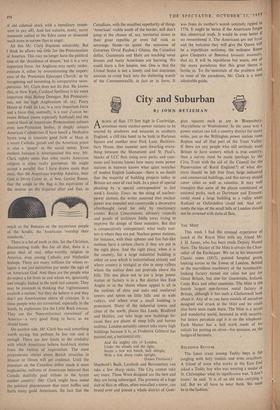City and Suburban
By JOHN BETJEMAN power was essential and countryside a decorative afterthought cared for only by reactionary cranks. Royal Commissions, advisory councils and panels of architects fiddle away trying to improve the design of these monsters. But that is comparatively unimportant; what really mat- ters is where they are put. Nuclear-power stations, for instance, with their spheres and fun fair-like outlines have a certain charm if they are put in the right place. And the right place, when it is the country, for a large industrial building is either an area which is industrialised already and where country is vestigial or else in steep valleys where the outline does not protrude above the hills. The one place not to put .a large power station or factory is in a flat district like East Anglia or in the 'shires whose appeal is all in the outlines of elms and oaks and medireval towers and spires on little hills and in wide -valleys, and where even a small building is prominent. Many of the industrial towns and cities of the north, places like Leeds, 'Bradford and Halifax, can take large new buildings be- cause they are places of steep hills and barren outlines. London certainly cannot take many high buildings because it is, as Frederick Gibberd has pointed out, a horizontal city.
And the mighty city of London,
Under the clouds and the light, Seems a low wet beach, half shingle, With a few sharp rocks upright.
(James Thomson.) Shepherd's Bush, Lambeth and Bermondsey can take a few sharp rocks. The City cannot take any more. Those Wren designed are the best and they are being submerged. The presence of a huge slab of flats or offices, often miscalled a tower, can brood over and poison a whole district of Geor-
gian squares such as are in BloomsburY. Marylebone or Westminster. In the same way a power station can kill a country district for maillf miles, just as the Willington power station ruins Repton and all that part of the Trent Valley. If there are any people who still seriously want Britain to have scenery which is true country, then a survey must be made (perhaps by the Civic Trust with the aid of the Council for the Preservation of Rural England?) of what dis- tricts should be left free from large industrial and commercial buildings, and this survey should cover cities as well as counties. It may well transpire that some of the places constituted as national parks, such as Dartmoor and Exmoor, could stand a large building in a valley while Rutland or Oxfordshire could not. And cer- tainly the tops of the small hills of London should not be crowned with slabs of flats.
THE MINT
This week I had the unusual experience of lunch at the Royal Mint with my. friend Mr. J. H. James, who has been made Deputy Master there. The Master of the Mint is always the Chan- cellor of the Exchequer. We sat in his enormous Classic room (1815), painted hospital green, looking across to the Tower of London. Behind us the marvellous machinery of the ramshackle- looking factory , turned out coins not just for Great Britain, but also for Guatemala, Iceland, Costa Rica and other countries. The Mint is the fourth largest non-ferroui metal factory in Britain, although it has such a Clerkenwell look about it. Any of us can have medals of ourselves designed and struck at the Mint and we could also have seals made there. The Mint is a secret and wonderful world, hemmed in with security, but letters percolate aid it is on the telephone. Each Master has a hall mark made of his initials for putting on silver—for instance, on the badges of baronets.
RELIGIOUS REVIVAL
The latest craze among Teddy boys is for jangling with holy medals and even crucifixes. A friend of mine who works in the East End asked a Teddy boy who was wearing a medal of St. Christopher what its significance was. 'I don't know,' he said. 'It is of an old man carrying a kid. But we all have to wear them. We must be in the fashion.'


































 Previous page
Previous page